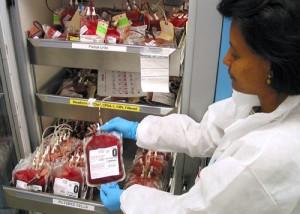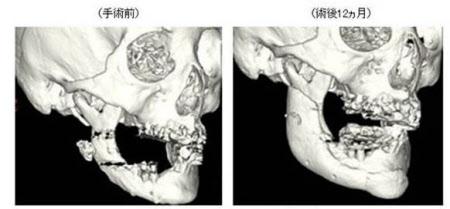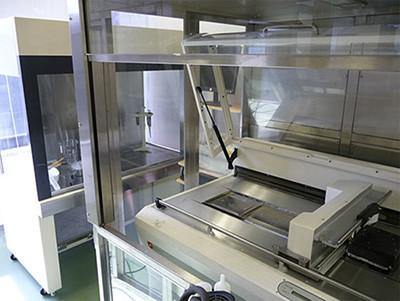We’ve all heard of blood banks, and other similar stockpiles of necessary supplies for those who might need bodily fluids, like platelets. One of my fondest memories from my youth was accompanying my mom when she’d go to donate platelets at the Cleveland Clinic. I’d watch a movie through the two-hour process, while she sat in the chair next to me, hooked up to the giant beeping machines that took her blood, ran it through to separate the platelets out, and returned the blood into her arm through another needle.

Typical blood banks stockpile large amounts of different kinds of blood
When I was finally of age to donate myself, the best I could muster at first was marking “organ donor” on my driver’s license; in college I finally gathered my courage to walk in to my first blood drive to donate to the Red Cross myself. Of course, the needle-phobic freshman got the trainee nurse, and I left with about 50% of my left arm taken up in one giant bruise. Once I finally built up a habit of donating, it didn’t last more than a few years, as I kept doing things to preclude myself from safe donation, like travelling to Southeast Asia or getting a tattoo. I assume at some point the blood I did manage to donate was used for someone who needed it — the perks of being a universal donor — but I have no way of knowing, and I’m ineligible again right now.
Trying to do the right thing, as it turns out, can be really difficult. Since I know how difficult my own donor odyssey has been, I can only imagine the stories donor banks hear all the time about why people can’t donate — and, most importantly, how that affects the people who desperately need the bio-material being collected. And that’s just for blood, one of the easiest materials to collect!
Patients need donor materials for all sorts of emergency situations, with the need high for blood, platelets, bone marrow, and even bones themselves. A new era is dawning, though, as 3D printing comes to the forefront of many fields of science, including health. We’ve seen so many impressive ways that 3D printed components have been used in the medical field, as surgical guides and as implants… what if there could be a way to stockpile some of these objects, ready at basically the drop of a hat to come to the aid of patients who require urgent bone grafts?
Researchers at the University of Tokyo have been working on just that idea, alongside NEXT21. The researchers have already developed 3D printing techniques to create bone, as seen at both the University‘s site and NEXT21‘s. 
The next step from these developments seems to be the mass production of 3D printed bones — which these research teams suggest might be in reach within the next three years. These mass produced bones could be created ahead of time and housed together much like a blood bank.
Multiple types of bones can be created, including hips, femurs, ulnae, humeri, cervical vertebrae, jawbones… with 206 bones in the complete adult skeleton, there are a lot of options! As we’ve seen with the rising use of 3D printed implants in surgical theatres, there is quite a strong demand for implants in reconstructive and emergency procedures around the world. By creating bones ahead of time, doctors can save precious time in surge ry — while still using appropriately shaped and sized bio-compatible materials.
ry — while still using appropriately shaped and sized bio-compatible materials.
These Japanese teams are using a technique based on “bone ink” for the filament, as it were, which is created from calcium phosphate, the same stuff that makes up our original bones. Several thousand bones could be produced each day using this bone ink, which melts at temperatures of about 100°-200°C, injected into shaped molds. By using calcium phosphate-based bone ink, the 3D printed bones will eventually fuse with the patient’s bones, recognizing like materials, which reduces the chance for post-surgical complications. These techniques, first announced last Spring, save significant amounts of money, energy, and time as compared to previously existing methods of creating bones. Currently, powders have to be heated to almost 800°C, as materials are combined via sintering techniques, requiring a high output of energy and at a high cost.
Do you think a bone bank would be a viable idea? Let us know your thoughts on this stockpiling theory over in the 3D Printed Bone Bank forum thread at 3DPB.com.
Subscribe to Our Email Newsletter
Stay up-to-date on all the latest news from the 3D printing industry and receive information and offers from third party vendors.
Print Services
Upload your 3D Models and get them printed quickly and efficiently.
You May Also Like
Metal Powder Supplier Elementum 3D Added to $46B Air Force Contract
Elementum 3D, a Colorado-based developer and supplier of metal powders used in additive manufacturing (AM), announced that the company has been added to the vendors list in the fourth on-ramp...
Ursa Major Lands $28.6M AFRL Deal for 3D Printed Draper Engine Flight Demo
The US Air Force Research Laboratory’s (AFRL’s) Rocket Propulsion Division at Edwards Air Force Base has awarded a $28.6 million contract to Ursa Major for follow-on work related to the...
3D Printing Financials: Rocket Lab’s Record-Breaking Year and Over 20 Launches Coming in 2025
Rocket Lab (Nasdaq: RKLB) closed 2024 with its best year yet. The company launched more rockets, signed more contracts, and expanded deeper into spacecraft and satellite production than ever before....
US Air Force Taps Beehive to Study 3D Printed Jet Engines
Propulsion 3D printing firm Beehive Industries secured a contract from the U.S. Air Force Life Cycle Management Center through SOSSEC. SOSSEC is a company that manages Other Transactions Authority (OTA)...


































